2002 FORD F SERIES MOTORHOME AND COMMERCIAL CHASSIS fuel filter
[x] Cancel search: fuel filterPage 6 of 104
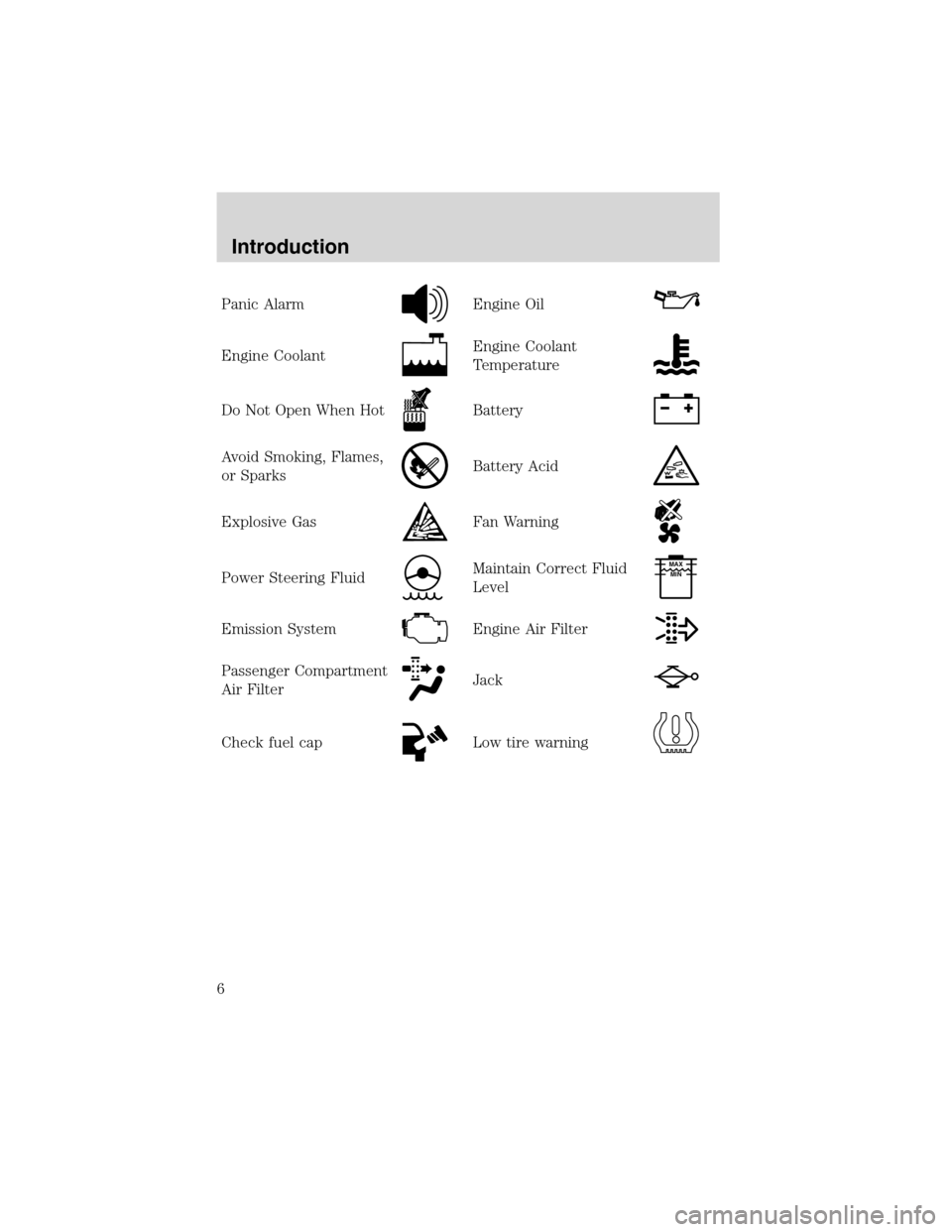
Panic AlarmEngine Oil
Engine CoolantEngine Coolant
Temperature
Do Not Open When HotBattery
Avoid Smoking, Flames,
or SparksBattery Acid
Explosive GasFan Warning
Power Steering FluidMaintain Correct Fluid
LevelMAX
MIN
Emission SystemEngine Air Filter
Passenger Compartment
Air FilterJack
Check fuel capLow tire warning
Introduction
6
Page 62 of 104

Adding engine oil
1. Check the engine oil. For instructions, refer toChecking the engine
oilin this chapter.
2. If the engine oil level is not within the MIN and MAX ranges, add only
certified engine oil of the recommended viscosity. Remove the engine oil
filler cap and use a funnel to pour the engine oil into the opening.
3. Recheck the engine oil level. Make sure the oil level is not above the
MAX mark on the engine oil level indicator (dipstick).
4. Install the indicator and ensure it is fully seated.
5. Fully install the engine oil filler cap by turning the filler cap clockwise
until three clicks can be heard.
To avoid possible oil loss, DO NOT operate the vehicle with the
engine oil level indicator and/or the engine oil filler cap removed.
Engine oil and filter recommendations
Look for this certification
trademark.
SAE 5W-20 engine oil is recommended.
Only use oils “Certified For Gasoline Engines” by the American
Petroleum Institute (API). Use Motorcraft or an equivalent oil meeting
Ford specification WSS-M2C153–H.SAE 5W-20 oil provides optimum
fuel economy and durability performance meeting all
requirements for your vehicle’s engine.
Do not use supplemental engine oil additives, oil treatments or engine
treatments. They are unnecessary and could, under certain conditions,
lead to engine damage which is not covered by your warranty.
Change your engine oil and filter according to the appropriate schedule
listed in the scheduled maintenance guide.
Maintenance and specifications
62
Page 76 of 104
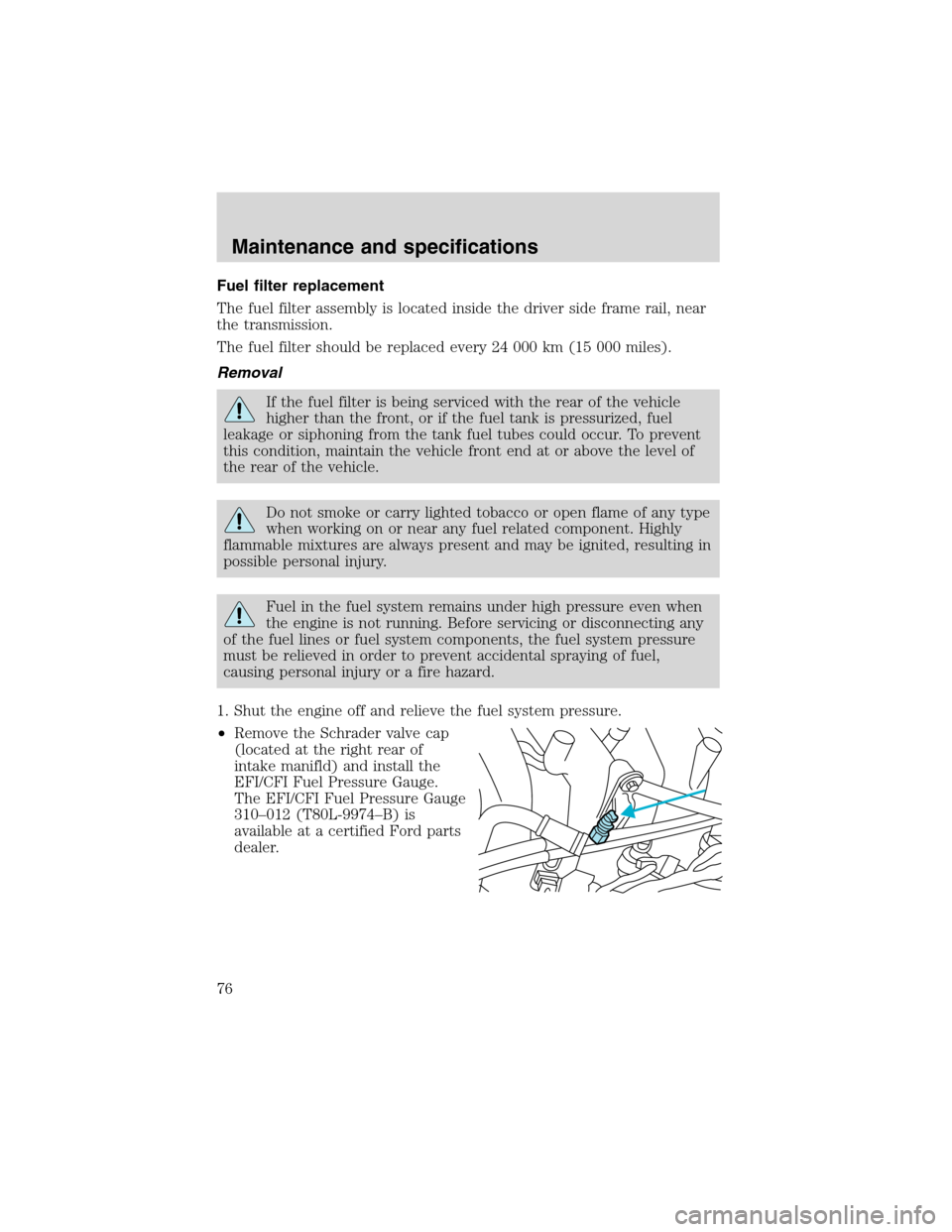
Fuel filter replacement
The fuel filter assembly is located inside the driver side frame rail, near
the transmission.
The fuel filter should be replaced every 24 000 km (15 000 miles).
Removal
If the fuel filter is being serviced with the rear of the vehicle
higher than the front, or if the fuel tank is pressurized, fuel
leakage or siphoning from the tank fuel tubes could occur. To prevent
this condition, maintain the vehicle front end at or above the level of
the rear of the vehicle.
Do not smoke or carry lighted tobacco or open flame of any type
when working on or near any fuel related component. Highly
flammable mixtures are always present and may be ignited, resulting in
possible personal injury.
Fuel in the fuel system remains under high pressure even when
the engine is not running. Before servicing or disconnecting any
of the fuel lines or fuel system components, the fuel system pressure
must be relieved in order to prevent accidental spraying of fuel,
causing personal injury or a fire hazard.
1. Shut the engine off and relieve the fuel system pressure.
•Remove the Schrader valve cap
(located at the right rear of
intake manifld) and install the
EFI/CFI Fuel Pressure Gauge.
The EFI/CFI Fuel Pressure Gauge
310–012 (T80L-9974–B) is
available at a certified Ford parts
dealer.
Maintenance and specifications
76
Page 77 of 104
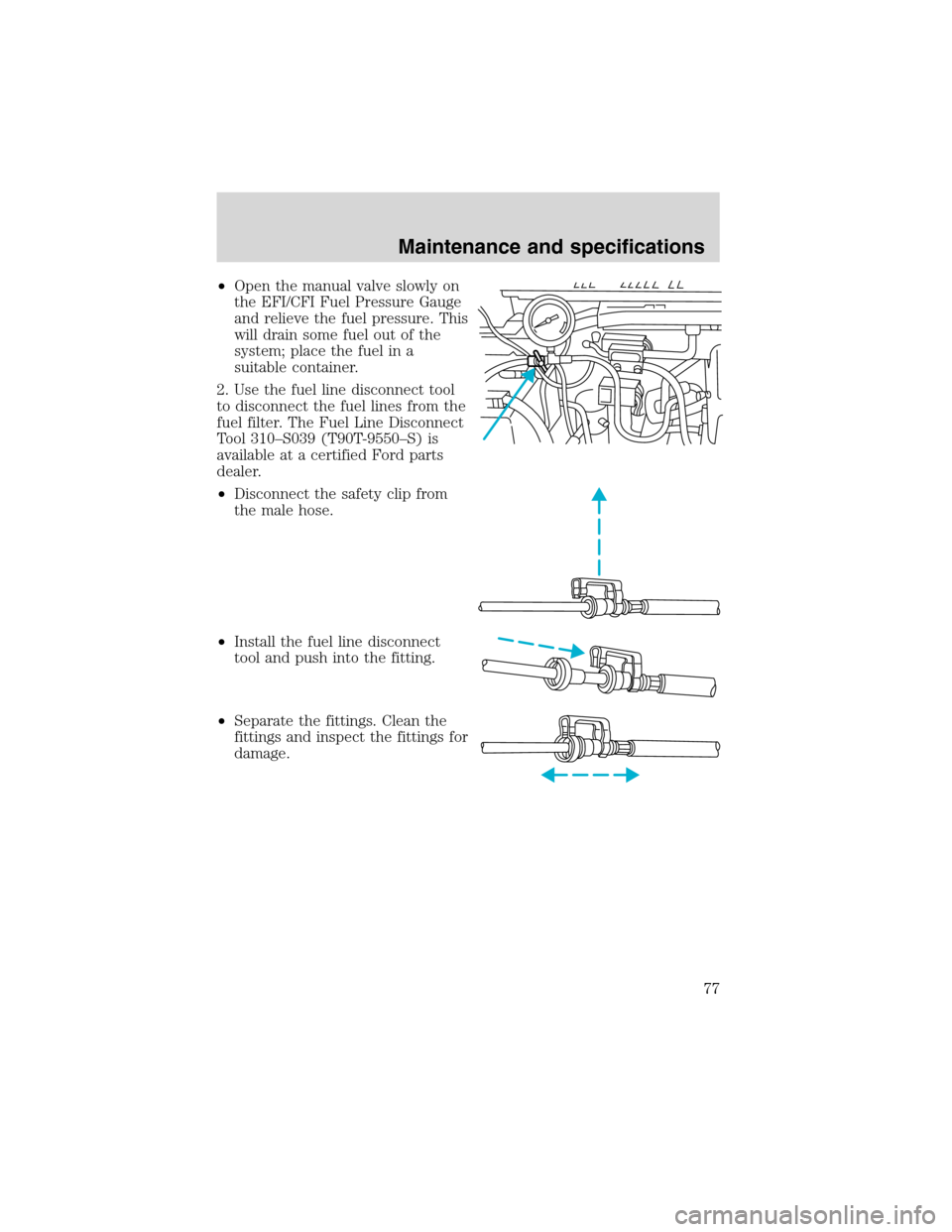
•Open the manual valve slowly on
the EFI/CFI Fuel Pressure Gauge
and relieve the fuel pressure. This
will drain some fuel out of the
system; place the fuel in a
suitable container.
2. Use the fuel line disconnect tool
to disconnect the fuel lines from the
fuel filter. The Fuel Line Disconnect
Tool 310–S039 (T90T-9550–S) is
available at a certified Ford parts
dealer.
•Disconnect the safety clip from
the male hose.
•Install the fuel line disconnect
tool and push into the fitting.
•Separate the fittings. Clean the
fittings and inspect the fittings for
damage.
Maintenance and specifications
77
Page 78 of 104
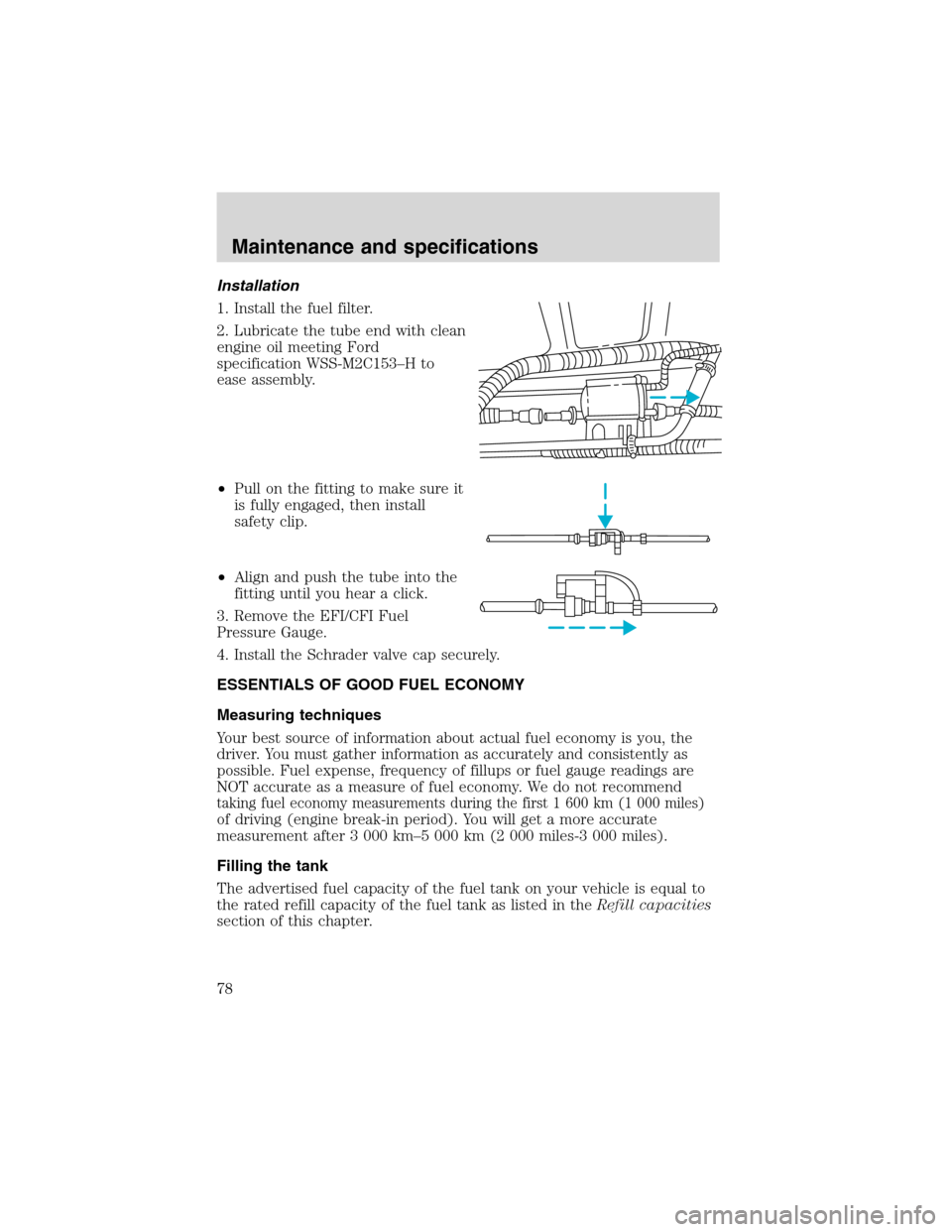
Installation
1. Install the fuel filter.
2. Lubricate the tube end with clean
engine oil meeting Ford
specification WSS-M2C153–H to
ease assembly.
•Pull on the fitting to make sure it
is fully engaged, then install
safety clip.
•Align and push the tube into the
fitting until you hear a click.
3. Remove the EFI/CFI Fuel
Pressure Gauge.
4. Install the Schrader valve cap securely.
ESSENTIALS OF GOOD FUEL ECONOMY
Measuring techniques
Your best source of information about actual fuel economy is you, the
driver. You must gather information as accurately and consistently as
possible. Fuel expense, frequency of fillups or fuel gauge readings are
NOT accurate as a measure of fuel economy. We do not recommend
taking fuel economy measurements during the first 1 600 km (1 000 miles)
of driving (engine break-in period). You will get a more accurate
measurement after 3 000 km–5 000 km (2 000 miles-3 000 miles).
Filling the tank
The advertised fuel capacity of the fuel tank on your vehicle is equal to
the rated refill capacity of the fuel tank as listed in theRefill capacities
section of this chapter.
Maintenance and specifications
78
Page 95 of 104
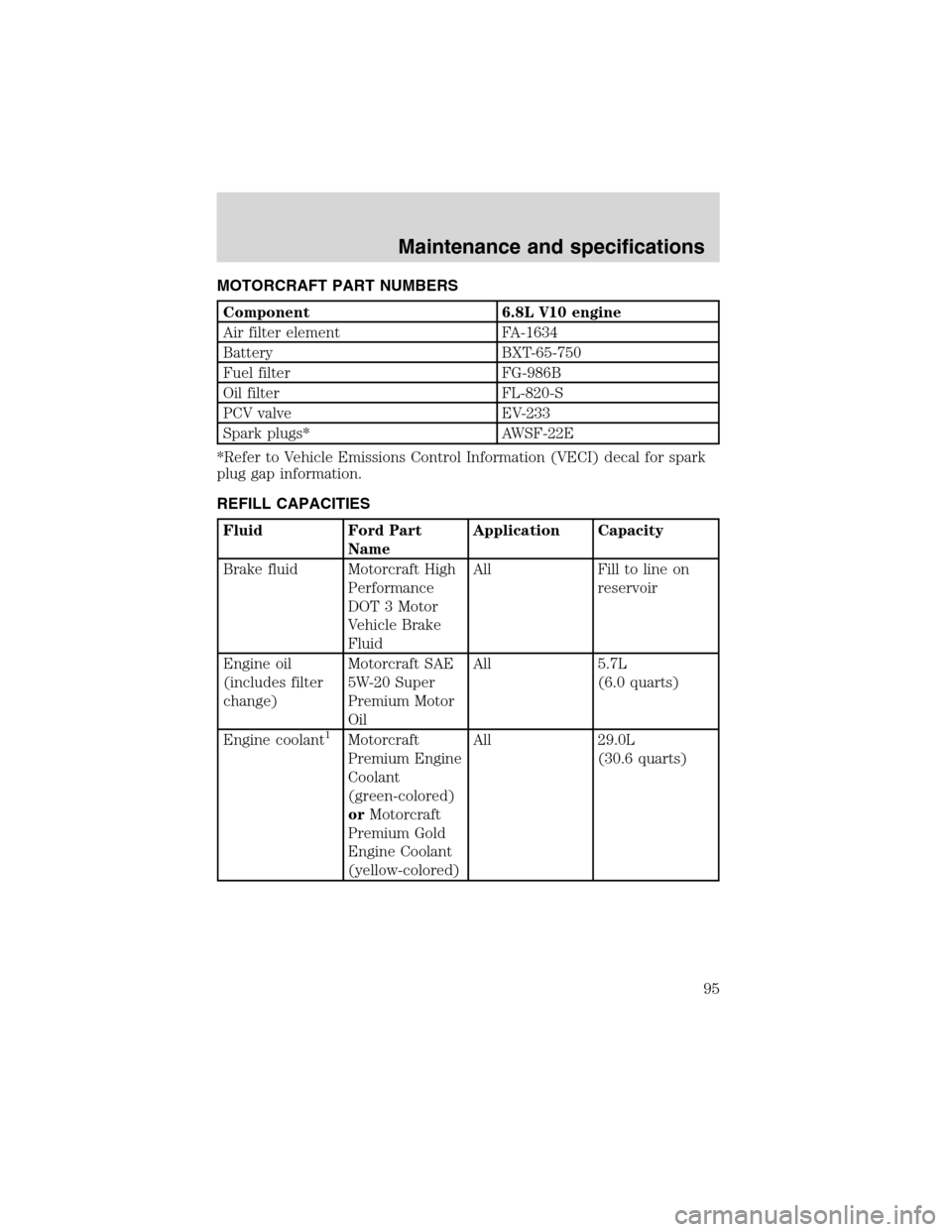
MOTORCRAFT PART NUMBERS
Component 6.8L V10 engine
Air filter element FA-1634
Battery BXT-65-750
Fuel filter FG-986B
Oil filter FL-820-S
PCV valve EV-233
Spark plugs* AWSF-22E
*Refer to Vehicle Emissions Control Information (VECI) decal for spark
plug gap information.
REFILL CAPACITIES
Fluid Ford Part
NameApplication Capacity
Brake fluid Motorcraft High
Performance
DOT 3 Motor
Vehicle Brake
FluidAll Fill to line on
reservoir
Engine oil
(includes filter
change)Motorcraft SAE
5W-20 Super
Premium Motor
OilAll 5.7L
(6.0 quarts)
Engine coolant
1Motorcraft
Premium Engine
Coolant
(green-colored)
orMotorcraft
Premium Gold
Engine Coolant
(yellow-colored)All 29.0L
(30.6 quarts)
Maintenance and specifications
95
Page 99 of 104
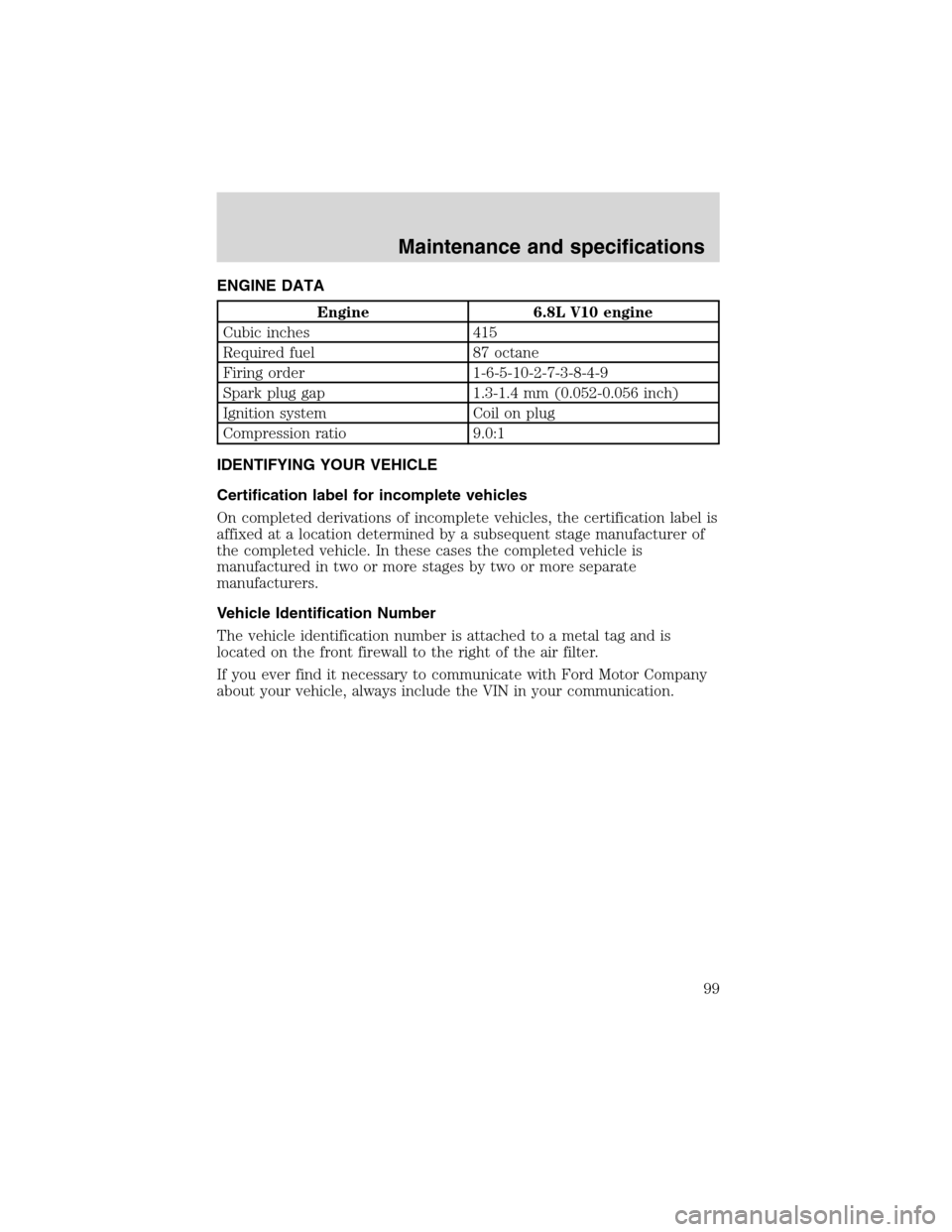
ENGINE DATA
Engine 6.8L V10 engine
Cubic inches 415
Required fuel 87 octane
Firing order 1-6-5-10-2-7-3-8-4-9
Spark plug gap 1.3-1.4 mm (0.052-0.056 inch)
Ignition system Coil on plug
Compression ratio 9.0:1
IDENTIFYING YOUR VEHICLE
Certification label for incomplete vehicles
On completed derivations of incomplete vehicles, the certification label is
affixed at a location determined by a subsequent stage manufacturer of
the completed vehicle. In these cases the completed vehicle is
manufactured in two or more stages by two or more separate
manufacturers.
Vehicle Identification Number
The vehicle identification number is attached to a metal tag and is
located on the front firewall to the right of the air filter.
If you ever find it necessary to communicate with Ford Motor Company
about your vehicle, always include the VIN in your communication.
Maintenance and specifications
99
Page 102 of 104

check engine/
service engine soon light ...........7
cleaning .....................................58
coolant .......................................65
fail-safe coolant ........................70
idle speed control .....................63
lubrication specifications ...97, 99
refill capacities ..........................95
service points ............................60
starting after a collision ...........39
Engine block heater ...................25
Engine oil ....................................61
checking and adding ................61
dipstick ......................................61
filter, specifications ............62, 95
recommendations .....................62
refill capacities ..........................95
specifications ......................97, 99
Exhaust fumes ............................25
F
Fail safe cooling ..........................70
Fluid capacities ...........................95
Fuel ..............................................72
calculating fuel economy .........78
capacity .....................................95
choosing the right fuel .............74
comparisons with EPA fuel
economy estimates ...................81
detergent in fuel .......................75
filling your vehicle
with fuel ..............................72, 78
filter, specifications ............76, 95
fuel pump shut-off switch .......39
gauge .........................................13
improving fuel economy ..........78
low fuel warning light ..............10
octane rating .......................74, 99
quality ........................................75running out of fuel ...................75
safety information relating
to automotive fuels ..................72
Fuses ............................................41
G
Gas mileage
(see Fuel economy) ...................78
Gauges .........................................11
battery voltage gauge ...............13
engine coolant
temperature gauge ...................12
engine oil pressure gauge ........12
fuel gauge ..................................13
odometer ...................................14
speedometer .............................13
tachometer ................................14
trip odometer ............................14
GAWR (Gross Axle
Weight Rating) ............................34
calculating .................................35
definition ...................................34
driving with a heavy load ........34
location ......................................34
GVWR (Gross Vehicle
Weight Rating) ............................34
calculating ...........................34–35
definition ...................................34
driving with a heavy load ........34
location ......................................34
H
Hazard flashers ...........................39
Headlamps ...................................15
daytime running lights .............15
flash to pass ..............................16
high beam ...........................11, 15
turning on and off ....................15
warning chime ..........................11
Index
102